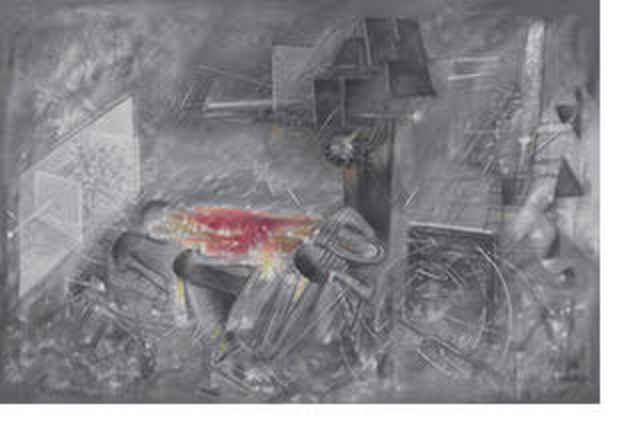Roberto Matta Echaurren “Matta in the 1950s and 1960s”
The Pace Gallery (32 E 57th St)

[Image: Roberto Matta Echaurren "Le vin des fleurs" (1969) oil on canvas, 7' 1" x 15' 3-3/4" © 2015 Robert Mangold /Artists Rights Society (ARS), New York.]
This event has ended.
Matta in the 1950s and 1960s is an exhibition of works by Roberto Matta Echaurren. The exhibition has been organized in close collaboration with the artist’s children, Federica Matta and Ramuntcho Matta. A new catalogue with an essay by art historian and critic Martica Sawin will accompany the exhibition.
Matta, born in Santiago, Chile in 1911, is a seminal figure in the canon of modern art. He was invited to join the Surrealists in 1937 by André Breton, who credited Matta for his discovery of new regions of space previously unseen in the field of art. With the onset of World War II, Matta left Europe for New York, where his introduction of automatist methods was influential to the development of Abstract Expressionism. His early works, referred to as “psychological morphologies,” explore states of the human subconscious. Matta’s reinvention of pictorial space was fueled by a deep interest in architecture and science, especially physics. He rejected a fixed vantage point in order to interpret the fluctuating energy in the universe, and sought to transform the traditional understanding of time and space.
The exhibition will present a selection of paintings and drawings from the 1950s and 1960s, when Matta was entering the very international second half of his life, living first in Rome and later in Paris. In the 1960s, Matta visited Cuba amidst the early optimism of its revolution, and traveled to his native Chile, where he painted a mural for Santiago’s Universidad Técnica. At this time in his career, Matta was moving away from a purely introspective focus and creating works that include aspects of the external world and postwar society.
In 1957, Matta was commissioned by UNESCO to create a large painting at their world headquarters in Paris. The mural, Les doutes des trois mondes, was painted in 1958 and uses scattered planes to convey expanding space, a compositional device first seen in Matta’s works of the late 1940s. Included in the exhibition is L’Impensable, a sculpture that Matta designed at the time of the UNESCO mural and created in 1959. The cast bronze sculpture speaks to the artist’s ability to work fluidly across diverse media.
La Question, 1957, oil on canvas, 78-3/4” x 9’ 8”. © 2015 Robert Mangold /Artists Rights Society (ARS), New York.Roberto Sebastian Antonio Matta Echaurren, (b. 1911, Santiago, Chile; d. 2002, Civitavecchia, Italy) “Matta,” earned a degree in architecture from the Universidad Catόlica of Santiago in 1932. After apprenticing at the atelier of Le Corbusier in Paris, he moved away from architecture and into painting. Matta was strongly influenced by poets Federico García Lorca, Gabriela Mistral and Pablo Neruda and the emotive nature of their work. In 1937, Breton invited him to join the Surrealist circle based on his potential to make new contributions to the existing practices of the liter ary, visual and political movement. The following year, four of Matta’s drawings were included in the Exposicion International du Surrealism at the Galerie des Beaux-Arts in Paris.
After settling in the United States for nearly a decade beginning in 1939, Matta returned to Europe, living in Rome from 1948 until 1955 and later in Paris, London and Tarquinia, an Etruscan city north of Rome. His near-constant travel exposed him to many cultures and profound thinkers, artists and revolutionaries. Multilingual, Matta experienced a fluidity of language and thinking that manifests itself in his work, unrestricted to a single system of thought.
Matta has been included in numerous international exhibitions, with mountings of nearly 400 solo exhibitions of his work. In 1957, the Museum of Modern Art, New York honored Matta with a major retrospective that later traveled to the Walker Art Center, Minneapolis (1957) and the Institute of Contemporary Art, Boston (1958). A major retrospective was hosted in 1985 at the Centre Georges Pompidou, Musée National d’art Moderne, Paris, and in 1999, the Museo Nacional Centro de Arte Reina Sofía, Madrid presented Matta, which later traveled to the Fundació Caixa Catalunya, Barcelona. In 2002, exhibitions of Matta’s works were presented at the Museum of Contemporary Art, Los Angeles (which traveled to the Miami Art Museum and the Museum of Contemporary Art, Chicago) as well as at the Musée d’Art Moderne et Contempo rain, Geneva. In 2011, a centennial exhibition of Matta’s work was hosted by Institut Valencià d’Art Modern, Spain, and traveled to Bilbao Fine Arts Museum. Other recent exhibitions have been held at the Art Museum of the Americas, Washington, D.C. (2003); Bucerius Kunst Forum, Hamburg (2012); Museum Frieder Burda, Baden-Baden (2013); Musée Cantini, Marseille (2013); and National Museum in Krakow (2013). An exhibition of Matta’s sculptures was presented at the Garden of Palazzo Soranzo Cappello in Venice earlier this year.
Matta’s work has been included in many significant group exhibitions including Documenta and the Venice Biennale, and is held in more than sixty public collections worldwide.
This is the third solo presentation of Matta’s work at Pace.
Media
Schedule
from November 06, 2015 to January 09, 2016
Opening Reception on 2015-11-05 from 18:00 to 20:00